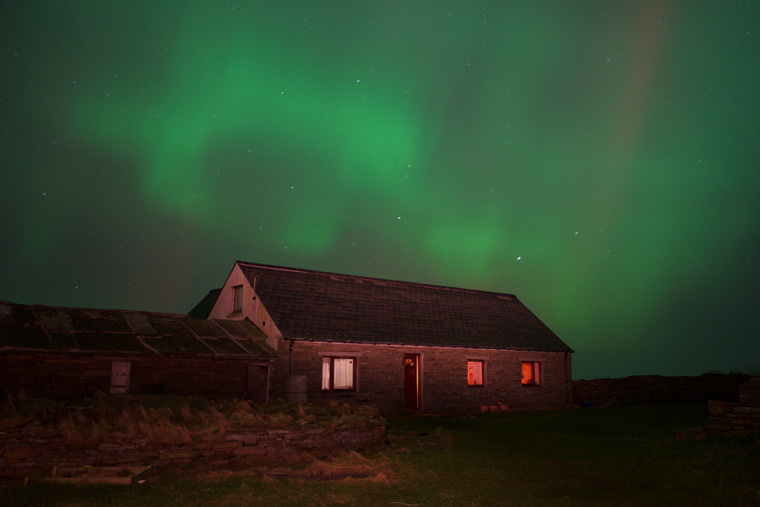Sanger croft house, North Ronaldsay, Orkney, with a backdrop of Merry Dancers (Aurora Borealis). Photo by Peter Donnelly.
ORKNEY, Scotland — North Ronaldsay of the Orkney Archipelago has been recognized as a Dark Sky Island and an International Dark Sky Community by the International Dark-Sky Association (IDA).
The island, far from sources of light pollution, is renowned for the darkness of its winter skies. IDA has now designated the island as an International Dark Sky Community, one of just over 30 worldwide. The list includes two other communities in Scotland – the island of Coll and the town of Moffat. North Ronaldsay also joins the handful of islands that have received an International Dark Sky Place Certification, such as Sark in the Channel Islands, the Dark Sky Nation of Niue, and the newly designated Pellworm and Spiekeroog Star Islands in Germany.
The announcement was made by the IDA during an Orkney International Science Festival online event featuring Scotland’s new Astronomer Royal, Prof. Catherine Heymans, and IDA’s Director of Conservation, Ashley Wilson.
IDA’s Executive Director Ruskin Hartley said today: “We are proud to recognize and celebrate the efforts of this community that spent a decade raising awareness and encouraging residents to embrace their connection with the night sky. By making this commitment, North Ronaldsay will embellish their economy, preserve important seabird habitat, and ensure the stars and cosmic wonders are shared by all who visit the Dark Sky Island.”
North Ronaldsay, Orkney’s northernmost island, has the UK’s tallest land-based lighthouse, and also unique seaweed-eating sheep, confined to the shore by the 13-mile-long drystone sheep dyke. Its position on the bird migration routes brings visitors to its bird observatory. The island is accessed by thrice-daily 15-minute flights from Kirkwall, and also by a weekly winter shipping service, twice weekly in summer. After a period of population decline, resident numbers in the community have started to grow again and are now above 60, and the school has reopened.
The island is known for the strength of the weather and tidal currents around it, which in the past caused many shipwrecks. “But in the autumn and winter months,” writes North Ronaldsay artist Ian Scott, “the island takes on another role, for then the night skies can be seen in all their majesty. On a clear, frosty night the stars shine and sparkle with even greater intensity in the blue-black velvety dome of the sky, with the constellations and planets making their rounds or the Milky Way tracing its great path across the heavens. And then, when the conditions are right, the Merry Dancers (the Aurora Borealis) can dominate the northern skies; sometimes a luminous, white changing curtain of light and at other times shimmering and dancing across the northern sky in beautiful colours of red and green.”
North Ronaldsay’s recognition is the outcome of a long process of assessment and community activity. The foundations were laid by the late Kathleen Scott of North Ronaldsay Community Association, who coordinated visits by astronomer Steve Owens and lighting engineer Jim Paterson for surveys of the island’s skies and outdoor lighting. She organized numerous astronomy activities on the island, including talks, night sky photography competitions, and a weekend astronomy conference.
The North Ronaldsay Trust continued her work and gathered further support from many people across Orkney and beyond. The former Astronomer Royal for Scotland, the late Prof. John C. Brown, agreed to become a patron of the proposal.
The live announcement for this certification may be found at this link.
Tagged with dark sky, lightED